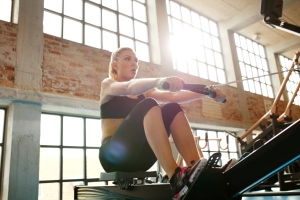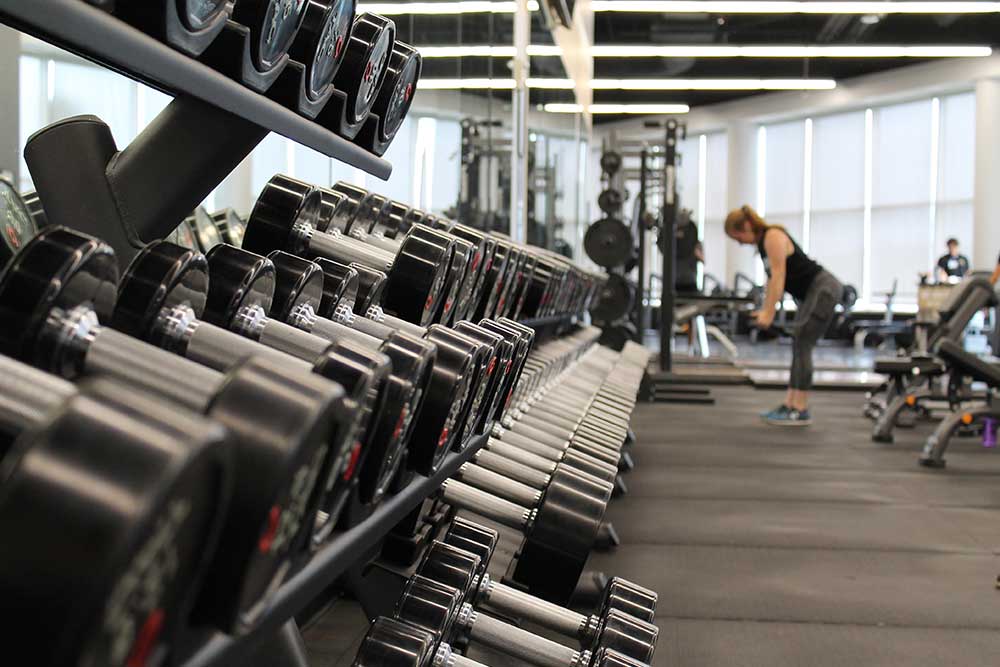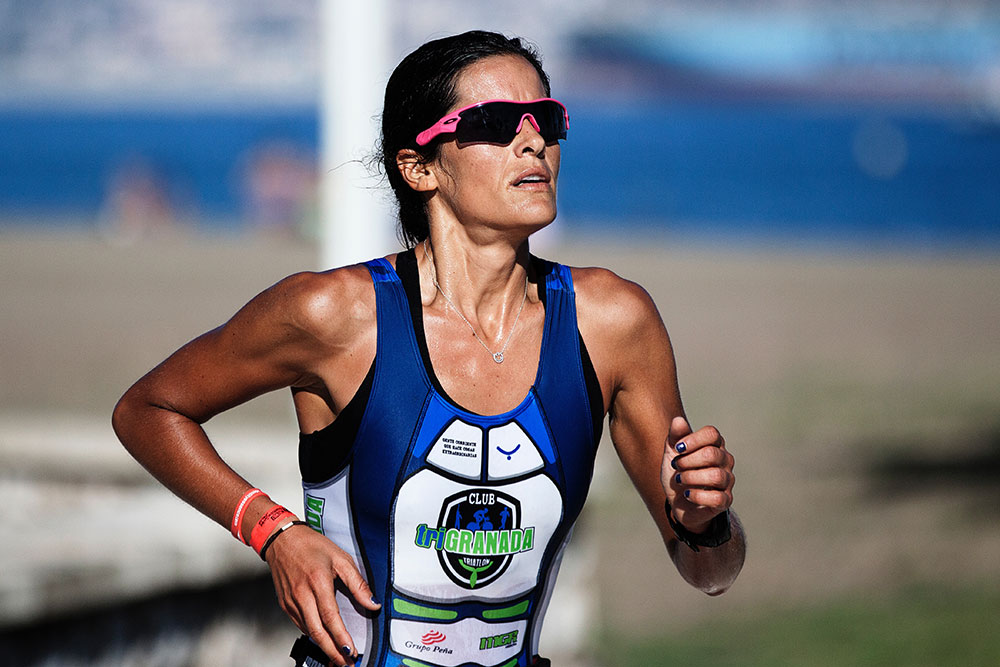HIIT- Does Non-Weight Bearing Rowing Do The trick?

Sarah West – PhD, Assistant Professor, Trent University
Recently, I contributed a series to the FTG research blog about the importance of maintaining bone health with aging. Bone loss can lead to Osteoporosis (i.e., thinning of the bones, and an increased risk of having a fracture), which is a very common disease that is associated with aging. Exercise is an effective and powerful way to help reduce this bone loss. In my previous series, I acknowledge that one of the best type of exercise to improve bone health is weight-bearing exercise, in other words, exercise that places forces and weight on your bones (such as running, walking, etc.).
However, we know that with aging there are also negative changes to how your muscles work and respond, as well as a decrease in balance and mobility. With these changes, there is an increased risk of falling with physical activity that can result in injury. Therefore, two important questions that are very relevant to the FTG blog discussion include: 1) Is high intensity interval training (HIIT; which commonly uses weight bearing types of exercises) really appropriate for the aging population?; 2) Is there a type of HIIT exercise that is beneficial for older adults who are unable to safely participate in weight bearing HIIT, such as individuals who have severe a balance problems?
I came across a newly published research article that begins to answer these questions about non-weight bearing rowing. The paper published by Hwang et al. titled “Novel all-extremity high-intensity interval training improves aerobic fitness, cardiac function and insulin resistance in healthy older adults” investigated whether a new type of non-weight bearing HIIT training was a safe and effective for older adults. To examine at this, Hwang et al. used a piece of exercise equipment similar to a stationary bike; as this eliminates the concern of balance and mobility associated with treadmill or other exercise protocols. Specifically, they looked at the safety and effectiveness of doing HIIT using a non-weight bearing all-extremity ergometer (where the legs and arms both are engaged in movement). They enrolled individuals who were between the ages of 55-79 years, and who were sedentary (i.e., were not currently engaging in regular physical activity).
Participants were randomized to one of three groups, the HIIT group, a moderate intensity continuous interval training (MICT) group, or a non-exercise control group. Those in the exercise groups performed all extremity non-weight bearing exercise on the cycle ergometer 4 days per week, over 8 weeks. The difference in training between the HIIT and MCIT exercise groups was the intensity of the activity they performed: the HIIT group did 4 x 4 minute active intervals at 90% of their peak heart rate (with active recovery in between), while the MICT group worked for 32 minute duration at 70% of their peak heart rate.
The results of this study were very interesting and exciting. The authors found that all-extremity non-weight bearing HIIT was feasible in older adults and they reported that there were no adverse events. This is an important finding because it supports the idea that non-weight bearing HIIT program is that it is safe for older adults. Hwang et al. looked at the impact of the HIIT and MICT exercise protocols on various outcomes, including fitness as well as something called insulin resistance (which we will discuss in further detail below). Fitness improved by 11% in the HIIT exercise group; but did not change in the MICT or non-exercise group. This is a very interesting finding- as it suggests that moderate intensity physical activity (which took even more time per session to perform) did not improve fitness whereas the high intensity activity did!
Insulin resistance is an important indicator of health, especially when it comes to metabolic health and diabetes prevention. Someone with Type-2 diabetes has high insulin resistance (i.e., is resistant to the effects of insulin in controlling blood sugar, and therefore may need to take extra insulin to help control blood sugar). Therefore, it is ideal to keep your insulin resistance low, as this means at a lower risk of developing metabolic syndrome or diabetes.
In the current study, the authors found that insulin resistance decreased by 26% in the HIIT group, and this was a statistically significant change compared to the MICT and control group. Insulin resistance did not change in the MICT or the control group. This is a very profound observation; only the HIIT protocol resulted in an improvement in insulin resistance. Therefore, Hwang et al. found that a unique type of non-weight bearing HIIT exercise was not only safe in older adults, it was more effective at improving fitness and metabolic health compared to moderate intensity exercise or no exercise at all.
 What I like about the findings of this study is the idea of accessibility of physical activity. We all contribute to the FTG research blog because we have experience researching and studying the effects of exercise in multiple populations. One important goal that I see in the field of exercise research is to create exercise programs that include all types of populations, including older individuals who may be mobile and have experience with exercise, as well as older individuals who may have balance issues and no experience with exercise. I think the study by Hwang et al. highlights the potent effects of HIIT; information that is not necessarily novel to us here at FTG. However, what this article has uniquely shown is that a HIIT exercise protocol may be modified to allow for safe exercise participation for many populations, with just as many benefits.
What I like about the findings of this study is the idea of accessibility of physical activity. We all contribute to the FTG research blog because we have experience researching and studying the effects of exercise in multiple populations. One important goal that I see in the field of exercise research is to create exercise programs that include all types of populations, including older individuals who may be mobile and have experience with exercise, as well as older individuals who may have balance issues and no experience with exercise. I think the study by Hwang et al. highlights the potent effects of HIIT; information that is not necessarily novel to us here at FTG. However, what this article has uniquely shown is that a HIIT exercise protocol may be modified to allow for safe exercise participation for many populations, with just as many benefits.
Non-Weight Bearing Rowing:
As an exercise physiologist who studies bone health, I am particularly interested in seeing if this type of non-weight bearing HIIT can positively impact bone health. As bone health researchers, we know that weight-bearing exercise is best for bone, but we also understand that any exercise that stimulates the muscle to grow and adapt can have a positive impact on bones as well. Therefore, I would love to see a “next step” study that examines whether or not the type of protocol studied by Hwang et al. can lead to better bone health as well. There are many future directions and potential applications of a safe non-weight bearing HIIT protocol such as the one tested by Hwang et al., and I know that I am most certainly interested to see this area of research grow and evolve!
Reference:
Hwang CL, Yoo JK, Kim HK, Hwang MH, Handberg EM, Peterson JW, Christou DD. Novel all-extremity high intensity interval training improves aerobic fitness, cardiac function and insulin resistance in older adults. September 2016 (currently e-pub ahead of print). Experimental Gerontology, 82, pp 112-119.










